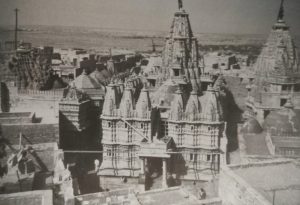Jaisalmer
 Jaisalmer, the desert city. is about three and a quarter centuries older than Bikaner. Even more ancient is Lodurva, seventeen kilometres north-west of Jaisalmer. Once a royal city. Lodurva was overrun by Muslim forces and totally destroyed in 1152.
Jaisalmer, the desert city. is about three and a quarter centuries older than Bikaner. Even more ancient is Lodurva, seventeen kilometres north-west of Jaisalmer. Once a royal city. Lodurva was overrun by Muslim forces and totally destroyed in 1152.
The present temple, dedicated to Parshvanatha, is of a later date. About halfway to Lodurva, on the southern side of the road, there lie, amidst natural beauty, extensive ruins of Jaina buildings. Restoration work is in progress.
An impressive architectural feat is constituted by the main temples inside the fort of Jaisalmer. They are dedicated to Parshvanatha, Adinatha, Shantinatha, Sambhava- natha and Mahavira. Having of necessity been erected within a very limited space. the southern complex could be taken for one large shrine.
dedicated to Parshvanatha, Adinatha, Shantinatha, Sambhava- natha and Mahavira. Having of necessity been erected within a very limited space. the southern complex could be taken for one large shrine.
This three-dimensional closeness of the four temples is in no way oppressive but rather inspiring. Each time, by taking a few steps round a corner, or up or down a staircase, something different catches one’s eyes. “There are.”
States a semi-official leaflet for visitors, “about seven hundred Jina idols over here, seven libraries with rare palm-leaf manuscripts. and eighteen upashrayas” (rooms for religious teaching and for providing temporary shelter to monks and nuns). One subterranean library is open to visitors.
 Jaisalmer was about the first place where western scholars gained entry into Jaina libraries. This in turn led to the publication of two volumes of Jaina Sutras in English translation in Max Mueller’s famous series of Sacred Books of the East (see bibliography).
Jaisalmer was about the first place where western scholars gained entry into Jaina libraries. This in turn led to the publication of two volumes of Jaina Sutras in English translation in Max Mueller’s famous series of Sacred Books of the East (see bibliography).
That was as far back as 1884 and 1895: but only now, over a hundred years later and still rather tentatively, a few western writers have begun to popularise the labour of the scholars for the benefit of the general reader. This guide is an example of what can be done, some day soon, to provide readable books on Jaina philosophy, art, ethics and culture for the shelves of every bigger library in western countries.
At present there would be not one in a hundred libraries of which this could be said, simply because of the lack of such books at reasonable prices. Many thousands of foreign tourists have visited Jaisalmer’s famous library as well as the temples at Mount Abu and Ranakpur during the last few decades, but back home very few of them will find one single book on Jaina religion, art and architecture on the shelves of their nearest library (a regrettable contrast to the general availability of books on Buddhism).
Unlike Bikaner, Jaisalmer’s once large Jaina community has dwindled to a few families. The partition of the subcontinent into Pakistan and India put an end to Jaisalmer as a centre of trade and commerce. However, hardly a day passes without a steady coming and going of Jaina pilgrims. It is by way of their donations that the local authorities are able to keep the entrusted sacred buildings, most of them were built in the fifteenth century, in good repair.
Jaisalmer. Jaina temple-complex within the fort, built in sandstone. Fifteenth century.
Mutilated Jina on outer wall of the ruined Jaina buildings halfway between Bikaner and Lodurva.